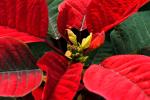COLUMBIA, Mo. – No flower says Christmas like the poinsettia. Now is the time of year when these colorful plants adorn mantels, tables and hallways across the country.
Originally from Mexico, poinsettia is the most popular potted plant in the United States. Every year poinsettia sales contribute more than $200 million to the U.S. economy, and in a very short time.
“All of the poinsettias are sold between the Wednesday before Thanksgiving and Christmas Day,” said David Trinklein, horticulture specialist and plant scientist for University of Missouri Extension. “A poinsettia on Dec. 26 is pretty much worthless.”
Poinsettia biology
To be ready for the holiday, these plants require long, dark nights to flower.
“The uninterrupted periods of darkness, which in nature is associated with a short day, is what triggers a poinsettia and other short-day plants to bloom,” Trinklein said.
The colorful part of the poinsettia that we enjoy isn’t a flower. They’re modified leaves called bracts. The true flowers, called cyathia, are the small structures found in the center of the bracts.
Today’s poinsettias are no longer just red. You can get them in creamy white, shades of pink and orange, marbled bracts of pink and white and even pink flecks on red. Many new poinsettia colors are created by mutation, not breeding, because bract color is genetically unstable, Trinklein said.
“Bract color mutates very easily,” he said. “Different colors are the result of chance mutations from the red.” He says it isn’t unusual in a greenhouse full of poinsettias to see a plant or two that has one bract cluster that has mutated.
Choosing a poinsettia
Once you’ve decided on the color you want, make sure the plant is healthy before you buy it. Trinklein says leaves and bracts should not show any wilting, which could mean problems with the roots.
He recommends looking at the underside of the leaves to make sure there’s no insect damage. Also, take a close look at the cyathia.
“It’s the presence of the true flower that indicates the plant is still relatively young,” Trinklein said. Make sure the true flowers are in the center of the bract. If the cyathia are missing, it’s likely the plant is past its prime.
Poinsettia care
Proper care will ensure that the poinsettia will stay beautiful throughout the holiday. Put the poinsettia in bright, indirect light, Trinklein says, and do not overwater the plant.
“Poinsettias, just like most members of the Euphorbiaceae plant family, do not like wet soil,” he said. “If the plant is sitting on a saucer—I call them rug savers—be sure to empty it after the pot drains following watering.”
Trinklein says there’s nothing worse than having water sitting in a saucer where it will be constantly wicked back up into the root zone. If your plants are wrapped in decorative foil, make sure there’s a hole in the foil so water can drain out.
It’s easy to determine when your poinsettia needs water, Trinklein says. Pick up the pot. If it feels light, it may need water. Then touch the surface of the soil. If the soil feels clammy or moist, it is best to wait before adding more water.
You can skip adding fertilizer or supplying plant food to the poinsettia, Trinklein says. At the time of sale the plant’s growth period is over, so its need for nutrients is minimal.
Read more http://extension.missouri.edu/news/DisplayStory.aspx?N=2404






